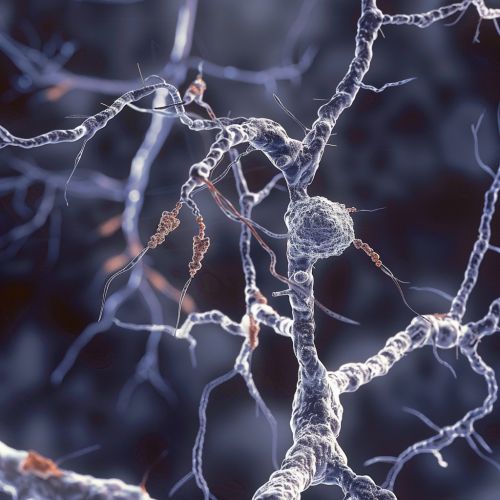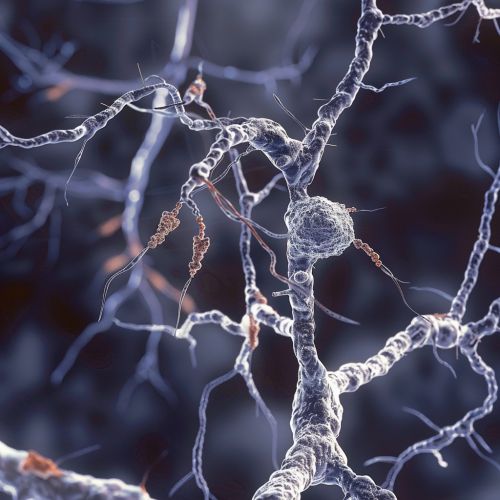Neural conduction
Introduction
Neural conduction refers to the process by which electrical impulses are transmitted along the axons of neurons. This fundamental mechanism is essential for the functioning of the nervous system, enabling communication between neurons, muscles, and glands. The process involves complex biophysical and biochemical events that facilitate the propagation of action potentials, the primary means of neural communication.
Basic Principles of Neural Conduction
Neural conduction relies on the movement of ions across the neuron's membrane, creating electrical signals known as action potentials. These action potentials are initiated when a neuron receives a sufficient stimulus, leading to a rapid change in membrane potential.
Resting Membrane Potential
The resting membrane potential is the electrical potential difference across the neuronal membrane when the neuron is not actively transmitting a signal. This potential is typically around -70 millivolts (mV) and is maintained by the differential distribution of ions, particularly sodium (Na+) and potassium (K+), across the membrane. The sodium-potassium pump plays a crucial role in maintaining this gradient by actively transporting Na+ out of the cell and K+ into the cell.
Action Potential
An action potential is a rapid, transient change in the membrane potential that travels along the axon. It is initiated when the membrane potential reaches a threshold, typically around -55 mV, due to the influx of Na+ ions through voltage-gated sodium channels. This depolarization is followed by the repolarization phase, where K+ ions exit the cell through voltage-gated potassium channels, restoring the membrane potential to its resting state.


Mechanisms of Neural Conduction
Neural conduction involves several key mechanisms that ensure the efficient transmission of action potentials along the axon.
Saltatory Conduction
In myelinated neurons, action potentials propagate via saltatory conduction. Myelin sheaths, produced by Schwann cells in the peripheral nervous system and oligodendrocytes in the central nervous system, insulate the axon and increase conduction velocity. Action potentials jump from one Node of Ranvier to the next, where the axonal membrane is exposed and rich in voltage-gated ion channels.
Continuous Conduction
In unmyelinated neurons, action potentials propagate through continuous conduction. This process involves the sequential opening and closing of voltage-gated ion channels along the entire length of the axon, resulting in a slower conduction velocity compared to saltatory conduction.
Factors Influencing Neural Conduction
Several factors can influence the speed and efficiency of neural conduction, including axon diameter, myelination, and temperature.
Axon Diameter
Larger axon diameters reduce the internal resistance to the flow of electrical current, thereby increasing conduction velocity. This principle is observed in various species, where larger axons are associated with faster reflexes and responses.
Myelination
Myelination significantly enhances conduction velocity by reducing the capacitance and increasing the electrical resistance of the axonal membrane. This allows for the rapid transmission of action potentials through saltatory conduction.
Temperature
Temperature can affect the kinetics of ion channels and the overall metabolic activity of neurons. Higher temperatures generally increase conduction velocity, while lower temperatures can slow down neural conduction.
Pathophysiology of Neural Conduction
Disruptions in neural conduction can lead to various neurological disorders. Understanding these pathophysiological mechanisms is crucial for developing therapeutic interventions.
Multiple Sclerosis
Multiple sclerosis (MS) is an autoimmune disorder characterized by the demyelination of neurons in the central nervous system. This demyelination disrupts saltatory conduction, leading to a range of neurological symptoms, including muscle weakness, coordination problems, and sensory disturbances.
Peripheral Neuropathy
Peripheral neuropathy involves damage to the peripheral nerves, which can impair neural conduction. Causes include diabetes, infections, and toxic exposures. Symptoms often include pain, numbness, and motor deficits.
Experimental Techniques in Studying Neural Conduction
Various experimental techniques are employed to study neural conduction, providing insights into the underlying mechanisms and potential therapeutic targets.
Electrophysiology
Electrophysiological techniques, such as patch-clamp recording and extracellular recording, are used to measure the electrical activity of neurons. These methods allow researchers to investigate the properties of ion channels and the dynamics of action potentials.
Imaging Techniques
Advanced imaging techniques, including magnetic resonance imaging (MRI) and positron emission tomography (PET), enable the visualization of neural activity and structural changes in the nervous system. These techniques are invaluable in diagnosing and monitoring neurological disorders.
